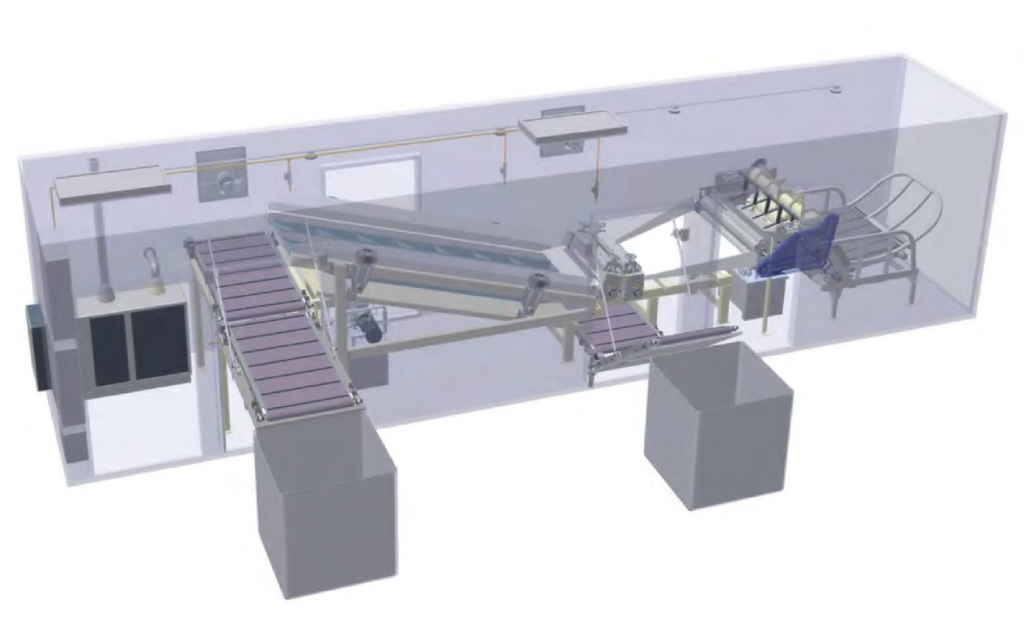Industrial Hemp
- Cultivation and use of hemp predate written history. Hemp was a critical crop for a number of civilisations including Europe.
- Industrial hemp is an herbaceous annual with phenomenal rates of growth. It is relatively easy to grow, preferring well drained soil, high levels of nutrients and water. It has few pest or disease problems apart from seed-eating birds. Under most conditions it will out-compete and smother weeds.
- Varietals of hemp produce high quality nutritious seed oil, top value fibre and strong stalk core with traditional and innovative end uses. Our Helical Hemp™ brand of hemp bricks made with chopped core and lime, and containing bioresin structural components, is a prime example.
Industrial hemp production and consumption have been continually falling throughout the world over the last hundred years due to competition from synthetics and prohibition of cannabis as a plant.
Industrial hemp offers the New Zealand agricultural and processing industries a fantastic and profitable primary product that sequesters CO2. Hemp is now viewed worldwide as a genuine sunrise industry. It is one of the most rapidly growing agricultural and industrial markets to emerge in decades.
There are thousands of known applications for industrial hemp, including bioplastics, construction, high protein foods and beverages, food supplements, textiles, paper products, composites, biofuel and graphene substitutes.
Benefits of Hemp
Habitat & Fibre's hemp operations deliver huge environmental benefits:
Carbon Sequestration
Enhanced Biodiversity
Land Reclamation & Phytoremediation
Environmentally Responsible Products & Service
Profitable Cash Crop for Farmers
- Hemp generates a reduced reliance upon cotton, whether from drought-stricken Australia or from Western China where most cotton is produced by forced Uyghur labour. A large reduction in cotton plantations is an international policy priority.
- The production of Hemp is carbon negative, which means it absorbs more carbon from the atmosphere during its growth than is emitted by the equipment used to harvest, process and transport it.
- Protecting the environment, hemp can be grown without the use of herbicides, pesticides or fungicides. Hemp is suitable for cultivation near surface water. Hemp is in the top 5 out of 23 crops for biodiversity friendliness, performing better than all major crops such as wheat, maize or rapeseed.
- Sequestering carbon, one hectare of industrial hemp can absorb 20 tonnes of CO2 per hectare. Hemp’s rapid growth makes it one of the fastest CO2-to-biomass conversion sectors at hand, scaling now – more efficient than agroforestry.
- With vigorous growth, hemp restores soil health. It serves as a pioneer plant that can be used for land reclamation and indeed phytoremediation – ‘cleaning’ land polluted by heavy metals. Hemp is a valuable preceding crop in rotations. After cultivation the soil is left in optimum condition.
- According to Defra in UK, modern farming emits a total CO2 equivalent of 57 million tonnes in greenhouse gases. UK agricultural land use is 18.5 million hectares. This amounts to an average of 3.1 tonnes of CO2 per hectare total embodied emissions. In comparison, one hectare of industrial hemp can absorb 20 tonnes of CO2 per hectare. Easily greenhoused, it is possible to grow two crops per year so CO2 absorption can be doubled. Hemp contains around 65-70% cellulose – wood contains around 40%, flax 65-75% and cotton up to 90%.
- Hemp represents a sustainable and carbon negative source of ‘plasticizing material.’ Making one tonne of steel emits 1.46 tonnes of CO2 and 198kg of CO2 is emitted to make one tonne of reinforced concrete. One square metre of timber framed, hemp-lime wall weighing 120kg, after allowing for the energy cost of transporting and assembling the materials, actually stores 36kg of CO2.
- Body panels and chassis components made from hemp fibre resin are lighter weight than steel or metal which improves fuel efficiency, while being far more dent resistant than steel
- Every bit of plastic, carpeting and upholstery in a car can be made of hemp resin. Porsche’s smoking hot new race car, the 718 Cayman GT4 features composite doors that use an organic fibre mix from hemp and flax. Porsche says the organic ingredients used are agricultural by-products, making it more environmentally friendly.
Carbon Negative
Industrial Hemp is an ancient “C3” plant species which means it can absorb CO2 up to 1200 parts per million. Our modern “C4” plants reach saturation and do not absorb additional CO2 beyond 500 ppm as cannabis does.
Hemp has a remarkable ability to absorb CO2 directly from the atmosphere. As global CO2 levels rise, hemp plants grow larger naturally. For every ton grown above-ground, another half a ton of carbon is stored in the soil as root mass, where it belongs. This creates a “carbon negative” opportunity to capture CO2 for the life of the products made from the crop.
Decortication
Key to hemp is cannabis decortication - the helical hemp™ edge
Processing the stalk material of the cannabis species is one tough job. Techniques used for centuries involve field retting (rotting), where stalks are cut and lie in the fields to allow their plant gum (lignum) to decompose. Another traditional technique has been to soak the stalks in pools of water to accomplish the same thing. This also serves to dissolve the woody core material or hurd. Problems with this, however, are twofold: a lot of the materials are degraded and damaged by these techniques; and in regions where there is not enough morning dew, field retting will fail altogether.
Depending on the cultivar grown and density of planting, hemp stalks can be very difficult to cut. Even the smaller stalks are much larger than typical grassland crops. Larger stalks are far tougher than corn or soy. Typical hay mowers are often not up to the job. Cutters with larger blades or mowing actions are needed. Some harvesters use triple level moving cutters. The height of Habitat & Fibre‘s Ukrainian specialty long fibre cultivars commonly reach 4+ meters, like thin bamboo.

Modified wheat harvesters can be used to cut the crop and collect the seed, but they tend to bind up on the tough stalk. Forage harvesters chop the stalk into specific lengths up to 8” long ~ but this contains the leaf, fibre and woody core all in the same mixture.
Processing the stalk by hand, separating the fibre from the hurd core is brutal labour. Methods of breaking the stalks crush the material with a brake. Waste and dust fill the air. Pulling the fibre from the stalks takes a lot of force. Comb-like structures are used to separate the fibre from the long-retted materials. Further work is required to make these raw fibres into useful forms.
Modern mechanization is the key to making this process more efficient. One of the first designs from the mid 1930’s did the work of hammering the stalks to separate the fibre. It was hailed as the invention that would transform the industrial cannabis processing. More modern technology has followed this same path: hammer mills. This is a way of processing large quantities of stalk to separate the fibre from the woody core. The finished process creates fibres that range in length from 5mm up to 15mm. This method is currently dominant in the industry sector. Many applications can use fibres of these lengths: insulation, textiles, rope, matting etc.
Habitat & Fibre, however, is bringing to New Zealand the latest best-build engineering innovations to process cannabis fibre. Our Canadian decorticator technology allows stalk material to be processed green in the fields or at a co-operative depot any time after cutting. Elimination of the retting process improves production, quality and quantity of the fibre and the uncertainty of weather conditions.
Our Company - Our Story
Habitat & Fibre is the result of a need and desire to innovate the building and land use practices in New Zealand. Working to start from the bottom up, we are helping to build the very foundation of Kiwi’s future lives. This is the way that we will build and celebrate our islands.
With housing and lumber shortages that continue to worsen, we saw the solution. Hemp as a sunrise industry is emerging from its intergenerational prohibition. We saw the opportunity to focus, promote and work with the massive array of non-psychoactive beneficial utilities of the hemp plant.
We slowly developed a realistic Future of Work game plan integrating quality management and development with solid team effort. A collaboration of recent graduates and veterans of the South Island industry make up Habitat & Fibre. It was founded to empower New Zealand through the sustainable use of self-sufficient resources, business methods and products with important functionality. We are steadily growing, offering appropriate technology suited to the specific needs of our islands while trading with the global market and industry.

